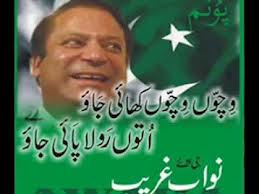In lucid moments, Mohammed Ilyas has happy memories of life as a fisherman on one of Karachi’s deep-sea shark boats. But that was 10 years ago, before Mr. Ilyas began smoking the low-grade heroin he knows as “brown sugar,” and before home became a threadbare blanket tacked to a grimy Karachi wall as a windbreak.
Now, Mr. Ilyas’s addiction brings him to the same lonely spot each night, with a sliver of silver paper to hold the heroin bought with a day’s panhandling in the docks, and a lighted taper to heat the powder into the vapors he inhales. On either side, fellow addicts crouch in their own pitiful isolation, ignored by the police and passers-by.
“What can I do, sir?” Mr. Ilyas asked on a recent evening, between pulls on the tube of rolled paper he uses as a pipe. “I would like to do something. I would like to be back with my family. But the brown sugar tastes too good.”
The tragedy for Pakistan set in much deeper 15 years ago, when Afghan warlords, thrown into turmoil by the Soviet military intervention in their country, stepped up the growing of opium poppies as other forms of commerce collapsed. The product, as opium gum, traveled down old trade routes into the deserts and mountains along Afghanistan’s border, where Pakistani frontiersmen, who grow tons of opium themselves, took the gum and ran it through refineries, producing the cheap “brown sugar” smoked by Mr. Ilyas, as well as heroin in its purer, more lucrative forms.
Over the years, as ever larger quantities of the narcotic began flowing into Karachi, Lahore, Peshawar and other cities, the drug ate its way into the fiber of Pakistan. Political life was corrupted, to the point that one of the country’s most notorious drug barons, Ayub Afridi, sat as an elected member of Parliament from 1988 to 1990, dropping out only when an ordinance was passed barring any known drug trafficker from running in an election.
Drug barons have continued to exercise a pervasive political influence, discouraging decisive government action against them.
What’s more, the backwash from the Afghan conflict has brought a flow of weapons into Pakistan, creating a nexus between the drug barons and new generation of heavily armed gangs. In Karachi mainly, but also in other cities, these gangs have established a terror that is overwhelming the local authorities.
Along with Afghanistan, and to a much smaller extent India, Pakistan has become one of the world’s leading producers of heroin — and by some estimates, a larger producer now than the Golden Triangle countries of Southeast Asia.
With growing anxiety, Western nations, including the United States, have been looking at Pakistan in the way they have long looked at countries like Colombia and Thailand — as a place where narcotics trafficking, left to run rampant, has become a danger not only to the country itself but also to much of the world.
Pakistani leaders have made no secret of their belief that drug money was in some way linked to the March 8 attack that killed two Americans working at the United States Consulate in Karachi, and to the terrorist underground that supported Ramzi Ahmed Yousef, a 27-year-old fugitive and suspected mastermind of the World Trade Center bombing in New York in 1993. Mr. Yousef was arrested in Islamabad, the Pakistani capital, in February.
These links are likely to be discussed when Pakistan’s Prime Minister, Benazir Bhutto, arrives in the United States on April 5. For five years, the main stumbling block to improved ties has been Pakistan’s persistence with a covert program to develop nuclear weapons. But on this visit, Pakistan’s Prime Minister may find American leaders at least as concerned about Pakistan’s role as a center for drugs and terrorism.
When she recently met with American reporters in Islamabad, Ms. Bhutto offered a stark picture of Pakistan as a society where torrents of drugs and weapons have combined to undermine the basis for a civil society.
“We are a clean Government,” she said. “For the first time in our history, we are going to take action against drug barons, militants and terrorists.”
Western embassies that have pressed for years for a narcotics crackdown were encouraged three months ago when the Government froze $70 million in assets belonging to seven leading Pakistani drug lords, and took steps, for the first time in Pakistan, to curb money laundering by drug bosses. The Government also announced the biggest raid on a narcotics laboratory in North-West Frontier Province, site of many of the heroin refineries, seizing 132 tons of hashish and nearly half a ton of heroin.
Ms. Bhutto also promised to speed up action by Pakistani courts on United States requests for the extradition of six drug lords held in Pakistan, and for the arrest and extradition of two others, including Mr. Afridi, the former legislator.
Maj. Gen. Salahuddin Termizi, the country’s anti-drug chief, has won the confidence of Western narcotics experts. But few with experience in combatting the drug world in Pakistan are ready to congratulate Ms. Bhutto just yet.
[ In a crackdown on the eve of the Bhutto trip, two suspected drug barons, Mirza Iqbal Baig and Anwar Khattak, were flown to the United States on April 3. The extraditions were cited by General Termizi as further proof of Pakistan’s commitment to rolling back booming drug production and trafficking. General Termizi said on April 4 that Pakistan had smashed the bulk of its heroin factories and arrested all but 2 of 12 leading drug barons. ]
Top army officers have been accused in the past of conniving with the drug lords, to the extent of running heroin shipments to Karachi aboard army-owned trucks.
And even if Pakistan were to live up to all of Ms. Bhutto’s promises, it would not tackle what has always been the core of the heroin problem: Afghanistan’s role as a secure hinterland for the traffickers. Years of efforts and millions of dollars have been spent by Western governments in an effort to persuade Afghan warlords to stop growing poppies and plant other crops, but poppy acreage has increased every year.
United States officials who have seen the blaze of white, red and pink poppies that cover much of Afghanistan each spring argue that little will be achieved until Washington shifts its spending priorities. The officials say spending $80 million of the State Department’s anti-narcotics budget on efforts to combat cocaine production in South America, and barely a tenth as much on all of Asia and Africa, means that efforts against heroin have to take a back seat.
Currently, the closest thing to a United States Government anti-narcotics program in Afghanistan is a $100,000 grant to Mercy Corps, an American volunteer agency that is trying to persuade communities in a small part of Helmand Province to substitute other cash crops for poppy-growing. Narcotics experts say that their work is hampered because Washington has no embassy in Kabul, the Afghan capital, and that the Clinton Administration has played virtually no part in efforts to negotiate peace between Afghan factions that have been fighting a civil war since Soviet troops withdrew.
When Mrs. Bhutto meets President Clinton, she seems likely to argue for an American responsibility to help Pakistan and Afghanistan deal with their narcotics problems. The argument is that Washington’s decision to channel billions of dollars in weapons and financial backing to the Afghan rebel groups in the 1980′s, without close scrutiny of the some of the Afghan leaders involved, contributed to a climate in which some of those leaders turned to heroin trafficking.
“We have been getting a bad name, and it is clear that our activity needs to be geared up,” Brig. Gen. Mohammed Aslam, deputy director of the new anti-narcotics force, said at his office in Rawalpindi.
But the general smiled when he was asked what part of the blame he attributed to the United States.
“I will only say this,” he said. “I believe that we in Pakistan are doing what we can to undo our part of the crime.”
Reference: http://www.nytimes.com/1995/04/05/world/heroin-scourges-million-pakistanis.html?pagewanted=all&src=pm



 We are in a state of war, even if Punjab and the national leadership from Punjab find it excruciatingly difficult to recognise this reality. From 1947 onwards the land of the sacred rivers didn’t prove itself very good at nation-building. Now with a different set of problems facing the country it is proving even less good at nation-saving.
We are in a state of war, even if Punjab and the national leadership from Punjab find it excruciatingly difficult to recognise this reality. From 1947 onwards the land of the sacred rivers didn’t prove itself very good at nation-building. Now with a different set of problems facing the country it is proving even less good at nation-saving.






